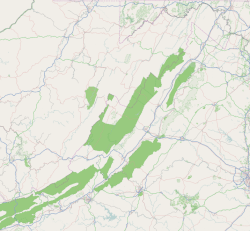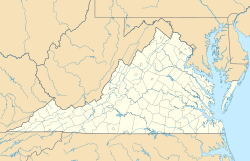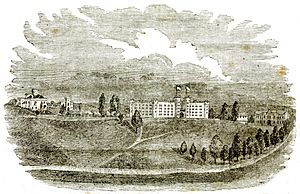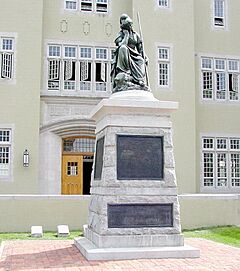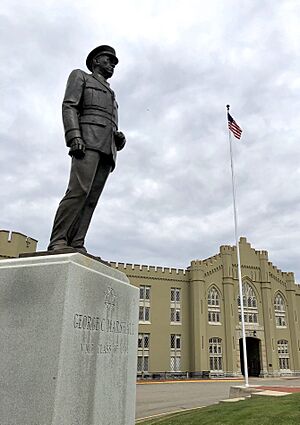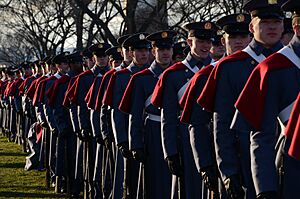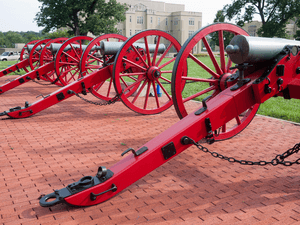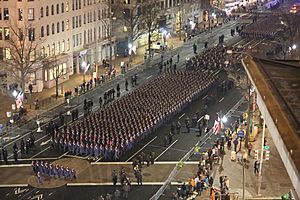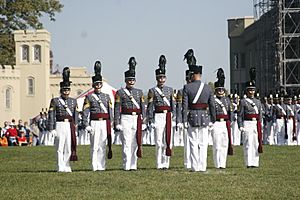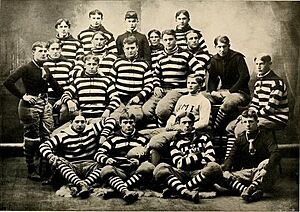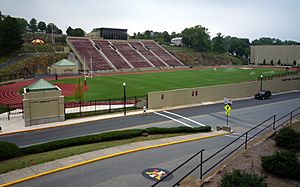Virginia Military Institute facts for kids
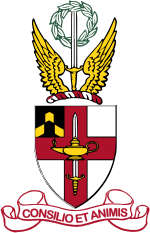 |
|
| Motto | Latin: In Pace Decus, In Bello Praesidium Latin: Consilio et Animis (on seal) |
|---|---|
|
Motto in English
|
"In peace a glorious asset, in war a tower of strength" "By courage and wisdom" (on seal) |
| Type | Public senior military college |
| Established | November 11, 1839 |
| Accreditation | SACS |
|
Academic affiliation
|
SCHEV |
| Endowment | $703.1 million (2021) |
| Superintendent | Cedric T. Wins |
|
Academic staff
|
178 (fall 2023) |
| Students | 1,560 (fall 2023) |
| Location |
,
United States
37°47′24″N 79°26′24″W / 37.790°N 79.440°W |
| Campus | Distant town, 134 acres (0.54 km2) |
| Newspaper | The Cadet |
| Colors | Red, yellow, and white |
| Nickname | Keydets |
|
Sporting affiliations
|
|
| Mascot | Moe the Kangaroo |
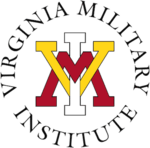 |
|
The Virginia Military Institute (VMI) is a public military college in Lexington, Virginia, United States. It was started in 1839. VMI was America's first state-supported military college. It is also the oldest public senior military college in the U.S.
Unlike other military colleges, VMI only enrolls cadets. Cadets are students who live under military rules. The institute only gives out bachelor's degrees. These degrees are in 14 different subjects. These subjects include engineering, science, and liberal arts.
Abraham Lincoln once called VMI "The West Point of the South." This was because of its role during the American Civil War. The nickname stuck because VMI has trained more Army generals than any other ROTC program in the U.S. ROTC stands for Reserve Officers' Training Corps.
VMI is smaller than federal military academies. In 2019, it had 1,722 cadets. Federal academies have about 4,500 students each. All VMI cadets must join an ROTC program. But they can choose to work in civilian jobs after graduating. Or they can become officers in the U.S. military. About 65% of VMI graduates join the military. This makes VMI a top trainer of officers for the Army and Marine Corps.
Contents
How VMI is Managed
The Board of Visitors oversees the Virginia Military Institute. The Governor of Virginia is the head of the institute. But the board makes most of the decisions. The board chooses the superintendent. They also approve new teachers and staff.
The board has 17 members. One member is the adjutant general of Virginia. The other members are chosen by the governor. They serve for four years. Most members must be VMI graduates.
The cadets at VMI are a military group. They are called the Corps of Cadets. The superintendent leads them. They also have a Commandant of Cadets. The cadets act as the guard for the institute.
VMI's Story
How VMI Started
After the War of 1812, Virginia built places to store weapons. These places were called arsenals. One arsenal was in Lexington. Local people did not like the soldiers guarding it. They thought the soldiers were not well-behaved.
In 1834, a local group discussed a new idea. They wondered if a military school could guard the arsenal. This school would be linked to Washington College. John Thomas Lewis Preston, a lawyer, strongly supported this idea. He suggested that students, living under military rules, could guard the arsenal. These students would also get a good education.
In 1836, the Virginia government approved the idea. The Governor signed the bill into law. The school's organizers formed a board. They chose Claudius Crozet as their first president. Crozet was an engineer who had worked for Napoleon. He also taught at West Point. The board asked Preston to name the new school. He chose Virginia Military Institute.
Crozet helped create VMI's learning plan. It was based on the United States Military Academy and a school in Paris. VMI became a strong engineering school. It offered one of the best engineering programs in America.
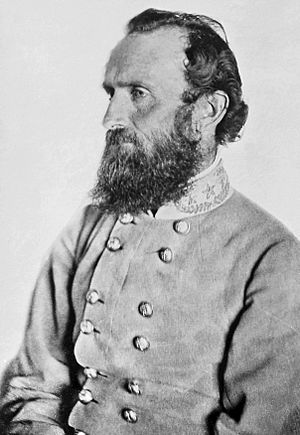
Preston also helped hire VMI's first superintendent. He found Francis Henney Smith, a West Point graduate. Smith became the first superintendent and a professor. Preston also joined the faculty as a language professor.
At first, VMI was part of Washington College. In 1839, it became its own school. This happened on November 11, 1839. Practical military training began in 1840. Since then, cadets have guarded the institute almost every hour.
Living conditions were tough at first. But they improved after 1850. In 1851, Thomas "Stonewall" Jackson became a professor. He taught natural and experimental philosophy. In 1859, VMI units were present at the hanging of John Brown.
The VMI Museum
In 1845, Superintendent Smith asked for items to start a museum. He wanted to inspire and teach cadets. In 1856, he accepted a Revolutionary War musket. This started the first public museum in Virginia.
Today, the VMI Museum System has several parts. It includes the VMI Museum on campus. It also has the Virginia Museum of the Civil War. And it includes the Jackson House. This house shows what life was like for Professor Jackson.
VMI During the Civil War
VMI cadets and alumni played big roles in the American Civil War. Cadets were called into battle 14 times. VMI honors these battles. But it only carries one battle streamer. This streamer is for the Battle of New Market. Many VMI cadets trained new soldiers.
About 1,800 VMI alumni fought for the South. About 250 of them died in battle. VMI graduates were seen as excellent officers. Some also fought for the Union. Fifteen graduates became generals for the South. One became a general for the Union.
Battle of New Market
On May 14, 1864, Virginia's governor called on VMI cadets. They marched 80 miles overnight. On May 15, 1864, 247 cadets fought at the Battle of New Market. This was the only time in U.S. history that a college's students fought as a unit in a battle.
General John C. Breckinridge was the Southern commander. He kept the cadets in reserve. He used them when Union troops broke through. Breckinridge said, "Put the boys in...and may God forgive me for the order." The VMI cadets held their ground. They pushed forward across a muddy field. They captured Union artillery. This helped the Confederates win.
VMI had 55 casualties. Five cadets died in the battle. Colonel Scott Shipp led the cadets. He was also wounded. VMI received a special battle streamer for its part in the battle.
Cadets Who Died at New Market
Five cadets were killed in action on May 15:
| Cadet | Hometown | Rank and Company | Notes |
|---|---|---|---|
| William Henry Cabell
Class of 1865 (Junior) |
Richmond, Virginia | Cadet First Sergeant
Company D |
Killed in action. Buried at Hollywood Cemetery, Richmond. |
| Charles Gay Crockett
Class of 1867 (Freshman) |
Wythe County, Virginia | Cadet Private
Company D |
Killed in action. Reburied at VMI in 1960. |
| Henry Jenner Jones
Class of 1867 (Freshman) |
King William County, Virginia | Cadet Private
Company D |
Killed in action. Buried at VMI. |
| William Hugh McDowell
Class of 1867 (Freshman) |
Beattie's Ford, North Carolina | Cadet Private
Company B |
Killed in action. Buried at VMI. |
| Jaqueline Beverly Stanard
Class of 1867 (Freshman) |
Orange, Virginia | Cadet Private
Company B |
Killed in action. Buried in Orange, Virginia. |
Five more cadets died later from their wounds:
| Cadet | Hometown | Rank and Company | Notes |
|---|---|---|---|
| Samuel Francis Atwill
Class of 1866 (Sophomore) |
Atwillton, Virginia | Cadet Corporal
Company A |
Died on July 20. Buried at VMI. |
| Alva Curtis Hartsfield
Class of 1866 (Sophomore) |
Wake County, North Carolina | Cadet Private
Company D |
Died on June 26. Buried in Petersburg. |
| Luther Cary Haynes
Class of 1867 (Freshman) |
Essex County, Virginia | Cadet Private
Company B |
Died on June 15. Buried at his family home. |
| Thomas Garland Jefferson
Class of 1867 (Freshman) |
Amelia County, Virginia | Cadet Private
Company B |
Died May 18. Buried at VMI. |
| Joseph Christopher Wheelwright
Class of 1867 (Freshman) |
Westmoreland County, Virginia | Cadet Private
Company C |
Died on June 2. Buried at VMI. |
VMI is Burned
On June 12, 1864, Union forces burned VMI. This was part of the Valley Campaigns of 1864. The museum was also destroyed. VMI had to hold classes in Richmond for a while. The destruction of VMI was one reason Confederate General Jubal A. Early burned Chambersburg, Pennsylvania.
After the Civil War
In April 1865, the VMI Corps of Cadets was sent home. The Lexington campus reopened on October 17, 1865. Francis H. Smith returned as superintendent. VMI became a model for other schools in the South.
After the war, Matthew Fontaine Maury, a famous oceanographer, taught at VMI. John Mercer Brooke also joined the school. Scott Shipp, who led cadets at New Market, became the second superintendent in 1890.
In 1903, a statue called Virginia Mourning Her Dead was dedicated. It was made by Moses Ezekiel, a VMI cadet who fought at New Market. Six of the ten cadets who died are buried behind this statue.
VMI in World War II
VMI trained many U.S. commanders in World War II. The most important was George C. Marshall (class of 1901). He was the top U.S. Army general during the war. Marshall was the first five-star general. He also won the Nobel Peace Prize. Winston Churchill called Marshall the "Architect of Victory."
Many other VMI graduates held important roles. They were commanders in the Army and Marine Corps. China's General Sun Li-jen, known as the "Rommel of the East," also graduated from VMI.
During the war, VMI helped train over 2,100 enlisted men. This was part of the Army Specialized Training Program.
Recent History
The "Old Barracks" was rebuilt after the war. A new wing, the "New Barracks," was finished in 1949.
In 1997, VMI started admitting female students. This made VMI a coeducational school.
In October 2020, the VMI Board of Visitors decided to move the Jackson statue. It was moved from the front of the barracks in December 2020.
Looking at Racism
VMI was the last public college in Virginia to admit black cadets. This happened in 1968. But problems with racism continued for a long time. In October 2020, Virginia's Governor Ralph Northam and other officials expressed concerns. They said there was a "culture of ongoing structural racism" at VMI. Students reported racist incidents.
Governor Northam, a VMI alumnus, ordered an investigation. Six days later, Superintendent Peay resigned. He said state leaders had "lost confidence" in him. Three days after that, the VMI Board of Visitors voted to remove the Jackson statue. They also planned to create a committee for building names.
In 2021, the board appointed the first black superintendent, Cedric T. Wins. He was expected to lead efforts for diversity. The board also decided to appoint a diversity officer. They created a diversity committee. And they started a plan to hire more diverse staff. A report in 2022 found that VMI had allowed a racist and sexist culture. It also said the leadership was unwilling to change.
In February 2025, the board decided not to extend Wins' contract.
VMI Superintendents
Since 1839, VMI has had fifteen superintendents. Twelve of them were VMI graduates.
- Francis H. Smith (1839–1889)
- Scott Shipp '59 (1890–1907)
- Edward W. Nichols '78 (1907–1924)
- William H. Cocke '94 (1924–1929)
- John A. Lejeune (1929–1937)
- Charles E. Kilbourne '94 (1937–1946)
- Richard J. Marshall '15 (1946–1952)
- William H. Milton Jr. '20 (1952–1960)
- George R. E. Shell '31 (1960–1971)
- Richard L. Irby '39 (1971–1981)
- Sam S. Walker (1981–1988)
- John W. Knapp '54 (1989–1995)
- Josiah Bunting III '63 (1995–2002)
- J. H. Binford Peay III '62 (2003–2020)
- Cedric T. Wins '85 (2021–2025)
VMI Campus
|
Virginia Military Institute Historic District
|
|
| Lua error in Module:Location_map at line 420: attempt to index field 'wikibase' (a nil value). | |
| Location | VMI campus, Lexington, Virginia |
|---|---|
| Area | 12 acres (4.9 ha) |
| Built | 1818 |
| Architect | Davis, A.J.; Goodhue, Bertram Grosvenor |
| Architectural style | Classical Revival, Gothic Revival |
| NRHP reference No. | 74002219 |
| Significant dates | |
| Added to NRHP | May 30, 1974 |
The VMI campus is called the "Post." This shows its military focus. The campus is 134 acres. All cadets live in a large five-story building called the "barracks." The Old Barracks is a historic landmark. It stands where the old arsenal was.
The barracks has two wings around two courtyards. A third wing was finished in 2009. The entries into the barracks are named after famous people. These include George Washington, Stonewall Jackson, George Marshall, and Jonathan Daniels.
VMI has raised over $275 million for campus improvements. This money helps expand the barracks. It also helps update academic buildings. VMI is also building a Center for Leadership and Ethics. This center will be used by VMI cadets and other students.
What Cadets Learn
VMI offers 14 main subjects and 23 minor subjects. These are in engineering, liberal arts, humanities, and sciences. Most classes are taught by full-time professors. Almost all of them have the highest degrees in their fields.
Within four months of graduating, most VMI graduates are doing well. About 97% are in the military, working, or in graduate school.
VMI has produced 11 Rhodes Scholars since 1921. Rhodes Scholars are students who get to study at Oxford University in England. VMI has more Rhodes Scholars per student than any other state-supported college.
School Rankings
In 2021, U.S. News & World Report ranked VMI fourth among public liberal arts colleges. It was ranked after the U.S. military academies.
Forbes magazine ranked VMI among the top 25 public universities in 2012. It was ranked 14th in "Top 25 Publics." This was ahead of other senior military colleges. Overall, VMI was 115th out of 650 colleges.
Military Training
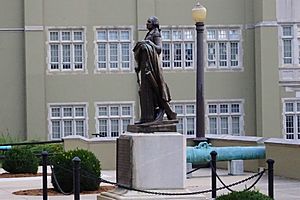
All cadets must take four years of ROTC. But joining the armed forces after graduation is optional. Over 50% of VMI graduates become officers each year. VMI wants this number to be 70%. In 2017, 57% of graduates became officers.
VMI alumni include over 285 general and flag officers. This includes George Marshall, the first five-star general. Seven alumni have received the Medal of Honor. This is the highest U.S. military award. VMI offers ROTC programs for five U.S. military branches.
VMI has trained more generals than any other ROTC program. Here are some U.S. four-star generals who graduated from VMI:
| Name | VMI class | Branch & date of rank |
Notes |
|---|---|---|---|
| George Marshall | 1901 | Army, September 1, 1939 |
|
| Thomas T. Handy | 1916 | Army, March 13, 1945 |
|
| Lemuel C. Shepherd, Jr. | 1917 | USMC, January 1, 1952 |
|
| Leonard T. Gerow | 1911 | Army, July 19, 1954 |
|
| Randolph M. Pate | 1921 | USMC, January 1, 1956 |
|
| Clark L. Ruffner | 1924 | Army, March 1, 1960 |
|
| David M. Maddox | 1960 | Army, July 9, 1992 |
|
| J. H. Binford Peay III | 1962 | Army, March 26, 1993 |
|
| John P. Jumper | 1966 | Air Force, November 17, 1997 |
|
| Darren W. McDew | 1982 | Air Force, May 5, 2014 |
|
VMI Students
To become a cadet, you must be 16 to 22 years old. You must be unmarried and have no children. You also need to be fit for ROTC. And you must have graduated from high school. The Class of 2022 had an average high school GPA of 3.70. Their average SAT score was 1210.
VMI tries to have no more than 45% of cadets from outside Virginia. Virginia residents pay less for tuition.
Welcoming Women to VMI
In 1990, the U.S. Department of Justice sued VMI. This was because VMI only admitted men. While the case was ongoing, a program for women was started at another college.
The case went to the U.S. Supreme Court. In 1996, the Court ruled that VMI could not exclude women. This was because it was a public school. VMI thought about becoming a private school. But the Department of Defense said it would remove ROTC programs if VMI did that. So, VMI decided to admit women.
In August 1997, VMI welcomed its first female cadets. Thirty women joined the Class of 2001. These first female cadets faced many challenges. They had to meet the same strict physical and training rules as male cadets.
Welcoming Minority Students
The first Jewish cadet, Moses Jacob Ezekiel, graduated in 1866. He fought at the Battle of New Market. He later became a sculptor. His works are at VMI. One of the first Asian cadets was Sun Li-jen, a Chinese general. He graduated in 1927.
The first African-American cadets were admitted in 1968. The first African-American regimental commander was Darren W. McDew, class of 1982. He later became a U.S. Air Force General. VMI has also had Muslim graduates from many countries.
Daily Life for Cadets
Cadets at VMI live simply. They sleep on foam mats called "hays." These must be rolled up every morning. Cadet uniforms have not changed much. The jacket worn in parades is from the War of 1812. New cadets, called "Rats," cannot watch TV or listen to music outside of class. Life at VMI is considered tougher than at other military colleges.
The Ratline
For their first six months, new cadets are called "Rats." This term has been used since the 1850s. Rats call their classmates "Brother Rats." The "Ratline" is an experience meant to build teamwork and discipline. Rats learn to march and clean their rifles. They also learn about cadet organizations.
Each Rat is paired with a senior cadet called a "Dyke." The Dyke acts as a mentor. The Ratline ends with "Breakout." This event officially welcomes Rats to the VMI community. After Breakout, Rats are officially fourth-class students. They no longer have to "strain" or eat "square meals."
The Breakout ceremony has changed over the years. It used to involve fighting through upperclassmen. Now, Rats do a tough day of physical activities. This tests their endurance and teamwork.
VMI Traditions
VMI has many traditions. These include the new cadet oath ceremony. There are also close-order marching parades. And "Taps" is played every night.
A very important event is the "Ring Figure" dance. This happens every November. Junior cadets receive their class rings. Most cadets get two rings. One is for formal wear, and one for everyday.
Every year, VMI honors its fallen cadets. This happens on New Market Day, May 15. This is the day of the Battle of New Market. During the ceremony, the names of cadets who died are called. Wreaths are placed on their graves. Since 2021, the ceremony also honors VMI graduates who died serving the United States.
A tradition of prayer before dinner was stopped in 2004. This was due to a lawsuit. The court ruled that mandatory prayer at a state-funded school was against the U.S. Constitution.
Guarding the institute is a very old tradition. Cadets have been posted as sentinels 24 hours a day since 1839. They wear traditional uniforms. Each sentinel carries an M14 rifle and bayonet.
The Honor Code
VMI is famous for its strict honor code. It says, "a cadet will not lie, cheat, steal, nor tolerate those who do." If a cadet breaks the honor code, they are immediately expelled. This is done in a "drumming out" ceremony. VMI is the only military college with this single-punishment honor code.
Clubs and Activities
VMI has over 50 clubs and groups. These include the student newspaper, The Cadet. There are also recreational activities, military groups, and music groups. VMI cadets helped start several fraternities. These include Alpha Tau Omega, Kappa Sigma Kappa, and Sigma Nu.
Sports at VMI
VMI has 14 sports teams. They compete in NCAA Division I. Sports include baseball, basketball, football, and lacrosse. VMI is part of the Southern Conference for most sports. The VMI team name is the Keydets. This is a slang term for "cadets."
VMI has one of the smallest enrollments for a Division I football college. About one-third of VMI cadets play on a sports team. This makes VMI one of the most active sports programs. Most VMI athletes graduate.
Football
VMI played its first football game in 1871. The current head coach is Scott Wachenheim. The Keydets play home games at Alumni Memorial Field at Foster Stadium. VMI won the 2020 Southern Conference Football Championship. This was their first winning football season since 1981.
Men's Basketball
The VMI basketball teams of 1976 and 1977 were very famous. The 1976 team almost reached the Final Four. In 1977, VMI had 26 wins and only four losses. This is still a school record. They reached the "Sweet 16" round of the NCAA tournament.
Famous VMI Alumni
VMI has many famous alumni. These include former governors of Virginia (Ralph Northam, Westmoreland Davis). George C. Marshall was a five-star general and Nobel Peace Prize winner. VMI alumni also include Pulitzer Prize winners and Rhodes Scholars. There are also Medal of Honor recipients. Many alumni are business leaders. Over 285 alumni have become general or flag officers.
VMI's Money
In 2007, a study found that VMI had a large endowment. Its $343 million endowment was the largest per student for any U.S. public college. An endowment is money given to a school to help it run. Private donations cover over 31% of VMI's budget. State funds cover 26%.
More to See
- Virginia Defense Force
- Virginia National Guard


